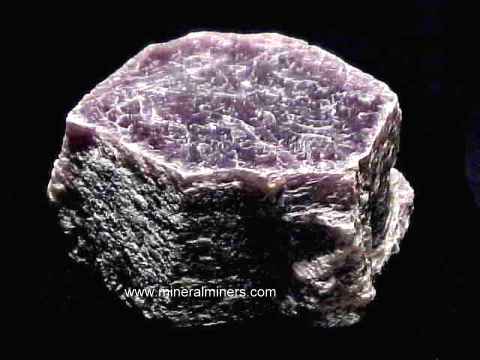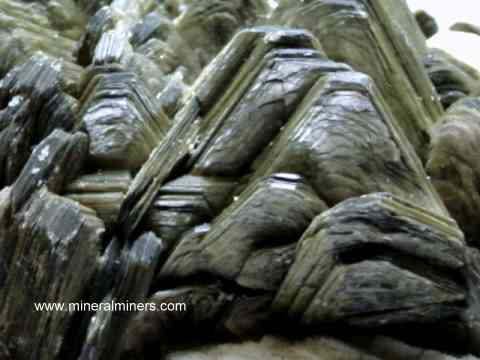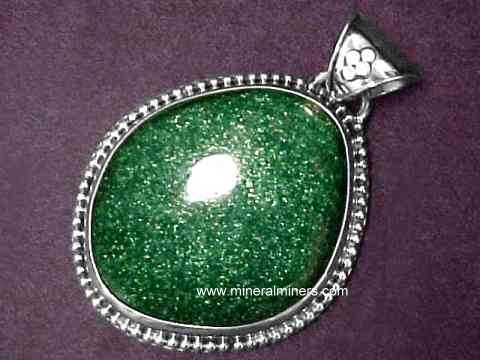


Enter our Online Store to see Fuchsite Mica Mineral Specimens
MINERALMINERS.COM® - Your Personal 'Link' Direct to the Fuchsite Mines!TM
Fuchsite Mica Mineral Information
With info on several of the Mica varieties: Biotite, Clinochlore, Fuchsite, Lepidolite, Muscovite, Seraphinite and Zinnwaldite
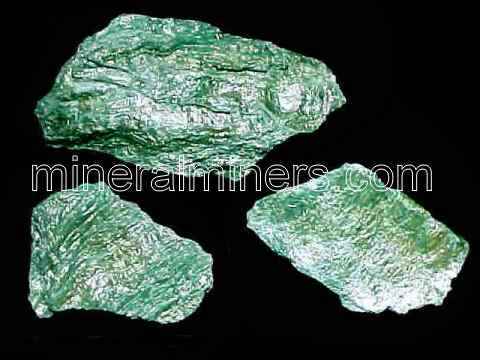
Fuchsite is a variety of muscovite mica.
When muscovite occurs with natural green color due to chromium impurities in the mica crystal structure is known as
Fuchsite is predominantly a metamorphic mineral occuring in mica schists. Fuchsite Mica Information Topics:
Natural Fuchsite Products in our Online Store
Return to the Index of
Micas
Each Mica Variety (Biotite, Fuchsite, Lepidolite, Muscovite...) and All Mica Products In Our Online Mica Store
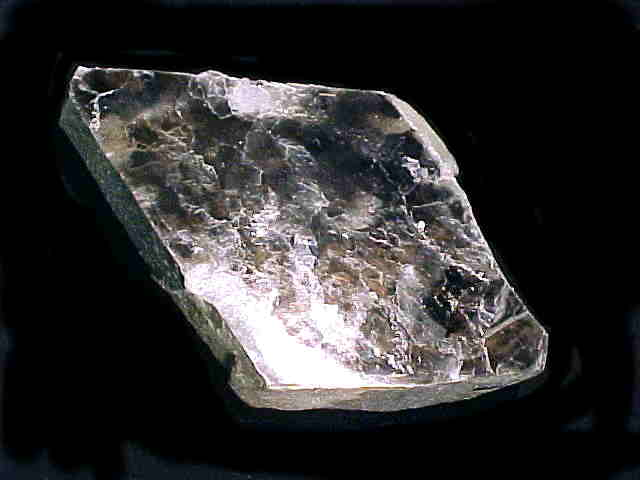 |
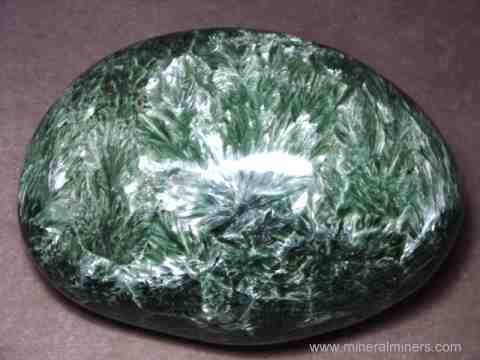 |
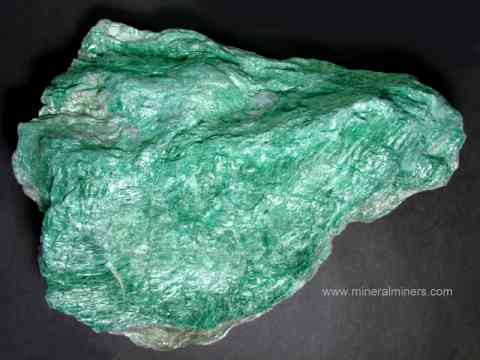 |
 |
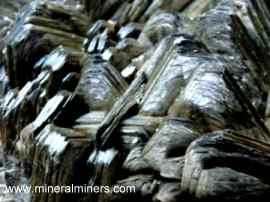 |
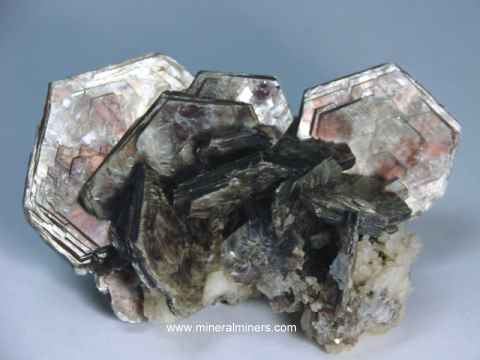 |
We specialize in fuchiste mica mineral specimens of all sizes including some very large fuchsites, and we do have more fuchsite specimens in stock. Be sure to see our selection of large fuchsite decorator specimens!
Return to the Index of
FUCHSITE MICA PHYSICAL PROPERTIES
- Chemical composition of fuchsite mica:
- Fuchsite: K2(Al,Cr)4Si6Al2O20(OH,F)4
- Fuchsite Mica Class: phyllosilicate
- Fuchsite Mica Crystal System: monoclinic; 2m
- Fuchsite Mica Crystal Habit: scaley, platy, micaceous, also compact massive. Distinct crystals are uncommon and are typically tabular with a book-like form with basal planes, showing a hexagonal or diamond-shaped outline. Prism faces are striated horizontally and frequently taper.
- Twinning: occaisional twinning on {110}, a twin axis in the {001} composition plane forms the complex mica twin.
- Fuchsite Mica Specific gravity: 2.86
- Fuchsite Mica Index of refraction: 1.595-1.604
- Birefringence: .036-.042
- Pleochroism: fuchsite in shades of green
- Fuchsite Mica Hardness: 2.5-3, hardness is greater perpendicular to the cleavage
- Color: fuchsite is an emerald green
- Fuchsite Mica Luster: vitreous, pearly, metallic
- Fuchsite Mica Transparency: translucent, transparent in thin sheets
- Fuchsite Mica Cleavage: perfect basal cleavage
- Streak: white
Return to the Index of
MICA BACKGROUND INFORMATION
The micas are complex hydrous potassium-aluminum silicate minerals. There are more than 20 chemically distinct mica species with considerable variance in geologic occurance, but all have essentially the same crystal structure. The micas crystallize with a sheet structure, the sheets being held together by relatively weak bonds resulting in the perfect basal cleavage of the micas.
Muscovite is the pure potassium mica, containing no impurities. Muscovite is colorless.
There are several muscovite varieties.
Fuchsite
mica is a chromium rich variety of muscovite where
chromium cations substitute for some of the octahedral aluminum in the
muscovite crystal structure.
The chromium impurities in fuchsite are
responsible for its emerald green color.
Lepidolite mica is a lithian mica where an occaisional lithium cation substitutes for some of the octahedral and tetrahedral aluminum in the mica crystal structure.
Zinnwaldite is a lithian ferrous mica, where lithium and iron cations substitute for some of the octahedral and tetrahedral aluminum.
Biotite is the most common of the micas, containing iron and/or magnesium impurities substituting for octahedral aluminum.
Return to the Index of
FUCHSITE MICA GEOLOGIC OCCURRENCE AND DIAGNOSTIC FEATURES
The micas have a very wide range of geological occurances. The many varieties of mica are distinguished by their chemical composition, some varieties occuring only in very specific geological settings while others have more widespread occurances.
Muscovite mica also is a very widespread and common rock forming mineral.
In igneous rocks, muscovite is characteristic of granites and granite pegmatites, and in metamorphic rocks it is very common especially in some mica schists where it is the most predominant mineral.
In some mica schists and quartzites, muscovite crystallizes with a significant percentage of chromium impurities resulting in the emerald green colored variety fuchsite.
When microscopic flakes of fuchsite crystallize inside of quartzite giving it a green color, the rock is known as green aventurine quartz which is a popular lapidary material for making natural color green aventurine jewelry.
Muscovite also commonly occurs as sericite, a fine-grained alteration product of other minerals.
Lepidolite mica occurs mainly in granitic pegmatites associated with
quartz, micrcoline,
albite, amblygonite and occaisionally the gem varieties of
tourmaline and spodumene.
Zinnwaldite mica occurs mainly in granite pegmatites and high temperature
hydrothermal veins.
Biotite mica is the most common of the micas, in fact it is the most common ferromagnesian mineral! It occurs in most igneous and metamorphic rocks and is commonly found in detrital sediments.
The micas are usually recognized by their perfect basal cleavage. Some mica varieties can be distinguished with reasonable certainty by their color. This is the case for the emerald green muscovite variety fuchsite.
Return to the Index of
FUCHSITE MICA HISTORY AND USES
The name mica was derived from the Latin micare which meant to shine. Biotite was named after the French physicist J. B. Biot. The name Muscovite was derived from the term muscovy-glass which it was previously known by because of its widespread use as a glass substitute in the old Russian state of Muscovy in the 14th century. The chromium-rich muscovite variety fuchsite was named after the German mineralogist Johann Nepomuk von Fuchs.
Mica (muscovite in particular) has a wide variety of uses as an insulating material in electrical equipment due to its strongly dielectric properties and to its good electrical resistivity and capacitance stability. Mica also has a low coefficient of expansion, and it has been used extensively because of its heat resisting properties. Mica is used extensively in paints to increase weatherability and to reduce running, it is also used in the manufacture of wallpapers to give them a silky or shiny luster. Mica is also used in the manufacture of lubricants and in dry-powder fire extinguishers.
Impurities within sandstones commonly alter to mica during high grade metamorphism. If chromium is present, then the green colored muscovite mica variety fuchsite can occur disseminated throughout the quartzite matrix in parallel orientation giving it a green color and a spangled effect. This material is known as green aventurine quartz.
Aventurine rough has been worked by man into ornamental objects for thousands of years. Green aventurine quartz is a popular lapidary material today, showing an atractive natural green color when polished or when wet.
In the past, green aventurine quartz has been miscalled Indian jade although the specific gravity and refractive index can readily identify aventurine quartz from jade.
The astrological sign of biotite is Scorpio, and the sign of muscovite is Aquarius.
Return to the Index of
METAPHYSICAL FUCHSITE PROPERTIES
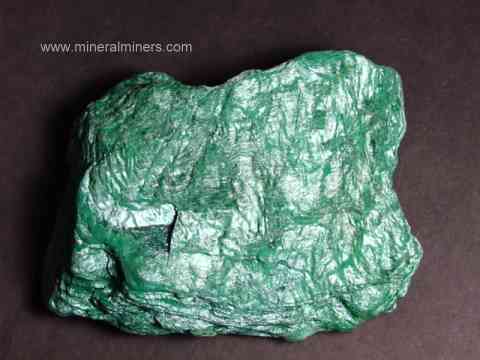 Fuchsite is said to enhance the body's ability to heal itself, and
to increase the effectiveness of other minerals that are being used in healing.
Fuchsite is said to enhance the body's ability to heal itself, and
to increase the effectiveness of other minerals that are being used in healing.
Biotite is said to enhance one's perception, allowing one to more clearly understand what is really happening in any situation.
Lepidolite is said to be very soothing and to have a calming effect, relieving anxiety and tension. Lepidolite with rubellite tourmaline (try holding a rubellite tourmaline in lepidolite sphere) is said to bring happiness, joy and increased vitality, and to inspire love.
Muscovite is said to increase one's understanding and perception, and to enhance one's reflective abilities.
For more in-depth metaphysical information, see our Metaphysical Books section.
Enter our Virtual Gallery of Fuchsite Mica Mineral Specimens
See also our rare Clinochlore Mica Mineral Spheres
and our Seraphinite Jewelry
This is the end of our Fuchsite Mica Factsheet and Information page.
Return to the Index of
Last Updated: October 15, 2024
© Copyright 1998-2024 Gem & Mineral Miners, Inc.® All Rights Reserved.
